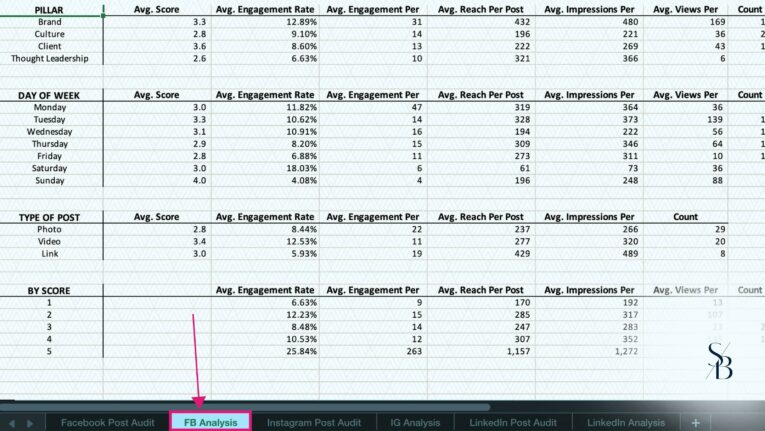The Art of the Social Media Audit
We've all heard the old saying about the cobbler's children being shoe-less, and as anyone in this industry knows, it can be a tall order to put the time and energy into our own brands when our clients' brands are calling. When you do (finally) find the time to tackle some long overdue brand maintenance, getting started can oftentimes be the hardest part.
Having launched our re-brand in January 2021, we wanted to take a step back and review our various social channels (Facebook, Instagram and LinkedIn) to ensure our content and our brand were living up to expectations. Our audit process brought countless valuable insights that allowed us to articulate issues we couldn’t before, which gave us room to reinforce our positioning and move forward with a clearer vision of how our brand would work for us.
Is it time consuming? Absolutely. Is it worth every minute? You betcha. We laid out our process below that any brand in any industry can use to save you some time—you don't even have to send us a 'thank you' note!
Audit Approach
Step 1: Export your posts natively from each platform (we chose to just audit the last year).
In most cases, your export will include the post info, link and performance. From here, you can build out a spreadsheet that works for you. We created a handful of columns based on things we felt could affect performance, such as Post Type (video, link, etc.), Day Posted, Notes, etc. Most importantly, we added in columns for Content Pillar and Score (more on these later).
To keep everything organized and in one place, we made separate tabs for each platform followed by a tab to analyze results.

Step 2: Categorize each post into appropriate content pillars.
If you haven't already built out a social strategy that includes content pillars, we highly recommend it. Consider the types of content you post and bucket them by larger themes.
For example, we use the following as our content pillars:
- Brand: All content promoting our own brand and services, including hiring posts.
- Clients: Case studies, sharing client work, behind-the-scenes content, etc.
- Thought Leadership: Content demonstrating our capabilities and expertise, such as blog posts, awards, etc.
- Culture: Highlighting the day-to-day in the office, showcasing our personality.
As we went through post-by-post, we selected the appropriate pillar in our spreadsheet.
Step 3: Score each post on a scale of 1-5.
It helps to blatantly define your scale so everyone is on the same page. The scale we used is simple:
- Never Again
- Needs Improvement
- Meets Expectations
- Exceeds Expectations
- Far Exceeds Expectations (Should be difficult to achieve, think Michelin Star)
Alongside this scale, it's important to spell out the other considerations that need to be accounted for with each score, for example:
- How well does it fit our brand positioning (visually, tone, culture, etc.)?
- Is it optimized for the channel? Does it align with channel best practices?
- Does it showcase our _______ skills?
- Does it highlight our _______ capabilities?
While scoring, make sure to note WHY it scored the way it did in your Notes column. For example, is it not optimized for the platform? Is the visual asset up to par? Is the copy descriptive and engaging? This helps during the analysis phase so you don't need to refer back to every post wondering why you scored it that way.
A decision we made in our audit process we would highly recommend: DO NOT take post performance into account when scoring. This might sound counter-intuitive, but at the end of the audit, when analyzing our own scoring results, we found our scoring aligned incredibly well with post performance, re-affirming the optimizations and revisions that were made to the social strategy as we went through the audit process.
Step 4: Analyze, analyze, analyze.
The world is your oyster…at least when it comes to Excel. Analyze your data by content pillar, by score, by post type, by whatever metric you measure success with, get wild!

As you can see by this snapshot, our lowest scoring posts by our own standards reflected that in performance, as noted above. This was helpful in validating our thoughts and plans for optimization moving forward, clearly highlighting that the posts we felt were best aligned with our brand and goals also resonated with our audience and accomplished what they were created to do.
So Why Is This Important?
Social media, more than other traditional media channels, is constantly evolving and changing. While you should have a social strategy that serves as a foundation, you absolutely should not just set it and forget it. Your strategy should be a living, breathing document—one you refer to frequently and optimize often. The only way to keep moving your business forward on social media is to be introspective and honest when evaluating your performance. This kind of data can be extremely enlightening, but only if you embrace the process and the datasheet.
Looking to improve your own social strategy and/or performance but don't have the time or the capacity to manage an audit?
Contact us today to start a conversation about how we can help move your business forward.
Subscribe to our newsletter
Want to know how S/B Strategic Marketing can move your business forward? Connect with us for a complimentary consultation.
In an effort to deliver an exquisite experience, this website uses cookies. To find out more see our Privacy Policy.